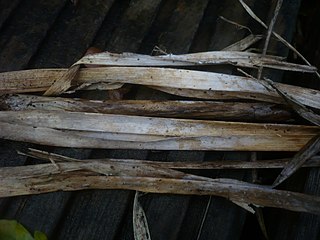Related Research Articles

Phanerochaete is a genus of crust fungi in the family Phanerochaetaceae.

The Meruliaceae are a family of fungi in the order Polyporales. According to a 2008 estimate, the family contains 47 genera and 420 species. As of April 2018, Index Fungorum accepts 645 species in the family.

The Phanerochaetaceae are a family of mostly crust fungi in the order Polyporales.

The Sparassidaceae are a family of fungi in the order Polyporales. The family was circumscribed by German botanist Wilhelm Herter in 1910 to contain the genus Sparassis. Sparassiella was added to the family in 1964. As of April 2018, Index Fungorum accepts 10 species in the Sparassidaceae.
Candelabrochaete is a genus of crust fungi in the family Phanerochaetaceae.
Roseograndinia is a fungal genus in the family Phanerochaetaceae. It is a monotypic genus, containing the single crust fungus species Roseograndinia rosea, recorded from tropical east Africa and from New Zealand.

Phlebiopsis is a genus of poroid crust fungi in the family Phanerochaetaceae. The genus contains 11 species, which collectively have a widespread distribution. The genome sequence of the type species, Phlebiopsis gigantea, was published in 2014.
Hjortstamia is a genus of corticioid fungi in the family Phanerochaetaceae. It was circumscribed by French mycologists Jacques Boidin and Gérard Gilles in 2003.
Australicium is a genus of corticioid fungi in the family Phanerochaetaceae. The genus was circumscribed by mycologists Kurt Hjortstam and Leif Ryvarden in 2002 to contain the type species, A. singulare, which is found in New Zealand. The Venezuelan species A. cylindrosporum was added to the genus in 2005.
Cericium is a fungal genus in the family Cystostereaceae. It is a monotypic genus with the single species Cericium luteoincrustatum, a crust fungus. This species was originally described in 1986 by Kurt Hjortstam and Leif Ryvarden, who called it Amethicium luteoincrustatum. They placed it in the genus Amethicium based on microscopic similarities with the African species Amethicium rimosum.
Parvodontia is a fungal genus in the family Cystostereaceae. This is a monotypic genus, containing the single species Parvodontia luteocystidia, a crust fungus that grows on bamboo in Brazil.

Hydnophlebia is a genus of five species of toothed crust fungi in the family Meruliaceae. All species are wood-decay fungi that cause a white rot.
Pirex is a fungal genus in the family Meruliaceae. It is a monotypic genus, containing the single crust fungus Pirex concentricus. It is found in the Pacific Northwest region of North America, where it causes a white rot in woody hardwood and conifer debris generated by timber harvesting.

Dentocorticium is a genus of six species of poroid fungi in the family Polyporaceae. The genus was revised in 2018, with several new species added and some older species transferred to other genera, based on phylogenetic analyses.

Epithele is a genus of crust fungi in the family Polyporaceae.

Nigroporus is a genus of poroid fungi in the family Steccherinaceae. The genus was circumscribed by American mycologist William Alphonso Murrill in 1905. Nigroporus has a pantropical distribution. The genus name combines the Latin word niger ("black") with the Ancient Greek word πόρος ("pore").
Gloeopeniophorella is a genus of crust-like, wood-decaying fungi in the family Russulaceae. It contains six known species. Gloeopeniophorella was first described by Brazilian mycologist Johannes Rick in 1934.
Crustodontia is a fungal genus of uncertain familial placement in the order Polyporales. The genus was circumscribed in 2005 to contain the crust fungus Crustodontia chrysocreas. This species was originally described as Corticium chrysocreas by Miles Berkeley and Moses Ashley Curtis in 1873. Their description was as follows: "Subiculum bright yellow, thin; hymenium immarginate pallid, or yellow tinged with tawny." Crustodontia has a monomitic hyphal system, meaning it contains only generative hyphae, and these hyphae have clamp connections.
Mycoacia rubiginosa is a species of toothed crust fungus in the family Meruliaceae. It was described as a new species in 2004 by mycologists Kurt Hjortstam and Leif Ryvarden. The type collection was made in Sierra Nevada de Santa Marta, in Magdalena, Colombia, where the fungus was found growing on dead hardwood. It is known only from the type locality. Fruit bodies of M. rubiginosa are distinguished by their reddish colour, and spines up to 3 mm (0.12 in) long. The hyphal system is monomitic, containing only generative hyphae. The spores are ellipsoid, smooth, thin-walled and translucent, with dimensions of 4–4.5 by 2.5–2.75 µm.
Efibula is a genus of 16 species of crust fungi in the family Irpicaceae.
References
- 1 2 Hjortstam, Kurt; Ryvarden, Leif (2004). "Some new tropical genera and species of corticioid fungi (Basidiomycotina, Aphyllophorales)". Synopsis Fungorum. 18: 20–32.
- ↑ Hjortstam, Kurt; Ryvarden, Leif (2007). "Some species of corticioid fungi (Basidiomycotina, Aphyllophorales) from Costa Rica". Synopsis Fungorum. 22: 17–24.
- ↑ "Record Details: Globuliciopsis Hjortstam & Ryvarden". Index Fungorum. CAB International. Retrieved 2016-11-04.